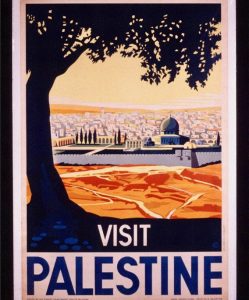
JR: Tell me about this image. I presume it is a tourism poster, yes? Do you know about its origin: when it was created and by who? What were the circumstances of your first encounter with it?
AY: This was originally a tourism poster created by an Austrian Jewish man named Franz Krausz in 1936. Krausz made many posters for zionist movement groups during this time, in order to promote immigration of Jewish people to the holy land. The image depicts the dome of the rock, which is a shrine located in Jerusalem. By 1948, most Israelis stopped referring to these lands as Palestine, which was after the founding of Israel. The tourism poster resurfaced during the Oslo Peace accords in the 90s. Graphic designer, David Tartakover, resurfaced the poster as a hope for coexistence between the Israelis and Palestinians. When the second Palestinian Intifada broke out, Palestinians repurposed the posters and hung them all across East Jerusalem as a symbol of resistance against the occupation, and more importantly, as an affirmation of Palestinian’s rights.
The circumstances of my first encounter with it were a bit odd. My parents are divorced, and I have never had a relationship with my dad. My mom is Mexican, and I grew up mostly with that culture. I knew my dad was Middle Eastern and his family migrated to Honduras, but I didn’t know where or when things happened. After doing research on my family ancestry and the family name Yacaman, I discovered that my family is originally from Bethlehem. Then I began looking at the social media accounts of my cousins on my dad’s side who I still have relationships with, and I found this “Visit Palestine” poster on one of my cousin’s accounts. I have done a lot of research since then on the occupation of Palestinians, and I have become far more aware of the issues surrounding it today.
JR: In what way or ways do you think the particular fascinating history of this print, its relationship to the history of conflict between Palestine and Israel, and your own personal, familial, connection to this part of the world contribute to your experience (and judgment) of the print as beautiful? What does that imply about how you understand that concept?
AY: I believe the history of this poster and its connection to the Israel-Palestine conflict and my own familial connection has a large impact on my judgment of the print as beautiful. Because I have learned about Palestinian occupation, and I have a familial connection to it, in combination with the fact that this poster was used as a protest against said occupation and I’m politically minded, it leads me to admire this poster and believe it’s beautiful. This implies that for me to believe something is beautiful, it helps for me to be passionate about the subject to think it’s beautiful.
JR: Tell me, if you can, what you see and understand in this poster (what it conveys to you and how it does that)? Especially, if you can, tell me about how you interpret it both (1) in light of your understanding of its history and (2) separate from that history and simply as an image.
AY: This poster conveys a message that Palestine is just that: Palestine. This poster is a symbol against the occupation of Palestinian territory, which has been recognized by the UN. It is a symbol of resistance and a humanizing thing for many Palestinians, for their lands to be sovereign with full rights. That is how I interpret it in understanding its history. Simply as an image, the image conveys these holy sites as being part of Palestine.
JR: How important is it (and in what ways is it important) for you to have beauty and experiences of beauty in your life and on a regular basis?
AY: It is important to have experiences of beauty in my life on a regular basis in meaningful ways. I did not select a random image on the internet as my beautiful image, because to me, what is beautiful must be personal. As someone with a very intersectional background, I push myself to read and look at different readings, art works, and more that are not typically viewed as beautiful to the rest of euro-centric society and their standards of beauty.